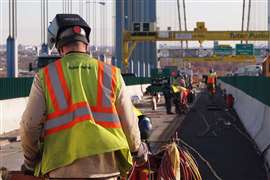Go East: infrastructure investment fuels strong growth in Eastern Europe
09 September 2008
With house building turning down in the wake of the global credit crunch, European construction output will shrink this year. However, growth is still strong in the developing Eastern economies and the infrastructure market in general looks buoyant. Chris Sleight reports.
After a buoyant few years, construction output in Europe is expected to fall this year. It will be the weakest the industry as a whole has been since 2002, but it is always a mistake to look at Europe as a whole.
In terms of countries, the Ireland, Italy, Spain and the UK will have a tough year, but central and Eastern Europe is looking as buoyant as ever. The view on different sectors is that the effects of the credit crunch will hurt house building - and this is the main cause of pain in Ireland, Spain and the UK - but civil engineering on the other hand remains generally buoyant across Europe.
In terms of the overall picture, mid-year figures from the Euroconstruct economic forecasting group say European construction output will -0,3% this year to € 1513 billion (US$ 2225 billion). The group, which is comprised of economic forecasting companies based around Europe, expects a return to growth in 2009, with a +0,2% increase in output, followed by a +1,6% expansion in 2010.
The Euroconstruct forecast covers 19 countries - Austria, Belgium, the Czech Republic, Denmark, Finland, France, Germany, Hungary, Ireland, Italy, Norway, Poland, Portugal, the Slovak Republic, Spain, Sweden, Switzerland, the Netherlands and the UK. Of these only five are expected to see a fall in construction activity this year, but with weak growth in most of Western Europe, this will be enough for an overall contraction.
The biggest fall will be in Ireland, which Euroconstruct says is looking at a -17,7% decline in construction output this year. More damaging to the overall picture though is the forecast -5,9% fall in Spain, the -2,1% drop in Italy and, to a lesser extent, the -0,5% contraction in the UK.
These three countries, along with France and Germany make up what is often called the ‘Big 5', because between them they account for about two thirds of European construction output.
With such big construction markets going into recession, moderate growth elsewhere in medium-sized Western European markets will not be strong enough to arrest an overall European construction recession. Indeed, the most promising markets in Western Europe this year hardly look stunning. The pick of the bunch are Finland, Sweden and the Netherlands, where +3.0%, +3.4% and +3.1% growth is expected respectively. Growth in Europe's other two major markets, Germany and France is expected to hit just +1.5% and +1.2% respectively.
Eastern boom
But while Western Europe looks weak, growth in Eastern Europe is expected to accelerate this year. Euroconstruct's forecast is for a massive +9.7% increase in construction across the Czech Republic, Hungary, Poland and the Slovak Republic this year, up sharply from 2007's +7.5% rise.
Most striking is Poland, where Euroconstruct expects a third straight year of double-digit growth, with construction output forecast to rise another +14.6% this year to € 40 billion (US$ 59 billion).
But although Europe's four largest emerging construction markets are showing strong growth, their total size this year will be just € 77 billion (US$ 113 billion), compared to the € 1436 billion (US$ 2111 billion) construction output in Western Europe. As a result, the high growth in Eastern Europe will only partly offset the lacklustre Western European markets.
There are other countries in Eastern Europe where growth is even more impressive. In Romania for example, the construction sector grew a massive +33.6% according to market research company PMR. Similarly buoyant are the Baltic States of Estonia, Latvia and Lithuania.
But in terms of absolute size these construction markets are small. PMR generously puts the Romanian market at € 15 billion (US$ 22 billion), and construction output in each of the Baltic States is at best € 3 billion (US$ 4.4 billion).
Infrastructure spending
One of the main drivers of growth in Eastern Europe is infrastructure construction, which has been given a missive boost by many of the region's countries joining the European Union (EU) in recent years. Membership of this free trade zone opens up access to a range of grants and loans designed to bring all infrastructure across the 27 Member States up to a comparable standard.
The most recent additions to the UE were Romania and Bulgaria in 2007, and the impact on their plans for infrastructure building is staggering. Romania for example expects to spend some € 5.7 billion (US$ 8.4 billion) on priority infrastructure projects - mainly roads - between 2007 and 2013, and about 80% of these funds will be in the form of EU-administered grants and loans.
But it is not just Eastern Europe where money is being spent on infrastructure. Last June saw the announcement of Fehmarn Belt fixed link between Germany and Denmark over a narrow strait in the western Baltic Sea. The scheme is due for completion in 2018, and is expected to comprise a 19 km bridge with three 700 m span cable stayed sections. These are required to allow ships to pass, and one consequence of this is that a 65 m clearance is required under the spans.
The cost for the road/rail link is put at some € 5 billion (US$ 7.35 billion). When complete it is expected to cut an hour from journey times by eliminating either a ferry crossing or a detour. As a result, the journey time by rail between Hamburg in Northern Germany and Copenhagen is expected to fall from 270 minutes to 210 minutes
Another major project to be approved last year was the London Crossrail scheme, which will see a new east-west rail link built under the UK capital and out into its suburbs. With a budget of UK£ 15.9 billion (US$ 29.6 billion), the industry is of course keen for construction work to get underway - currently scheduled for 2010. The first trains are due to run in 2017.
Crossrail, along with the 2012 London Olympics is making the UK capital something of a hotbed of construction activity. It is certainly welcome, with the UK house building market in crisis following the credit crunch, and construction activity in decline for the first time since the recession of the early 1990s. The total public sector budget for the Olympics is UK£ 9.4 billion (US$ 17.5 billion), most of which is construction related, be it the venues themselves or the associated infrastructure.
Cartels
But while civil engineering work sees to be propping up the European construction industry, it still has its problems to face. One issue that never seems to go away is that of anti-competitive behaviour, and over the last 12 months there have been a string of major prosecutions in the region.
The largest came at the end of 2007 when the European Commission handed out fines of € 487 million (US$ 716 million) to four glass manufacturers. The Commission said AGC Flat Glass Europe - a subsidiary of Japan's Asahi Glass Company, Guardian, Pilkington - a subsidiary of Japan's Nippon Sheet Glass (NSG) and Saint-Gobain abused their position of an 80% market share in the European market for flat glass (which is used exclusively in construction) to fix prices, agree future price rises and exchange confidential information in 2004 and 2005.
Unlike other recent cases in the European construction industry, there was no ‘whistle blower' company to come forward from the cartel. The Commission started the investigation under its own initiative based on information form several Member States' national competition authorities. As a result, none of the four companies had their fines reduced under leniency rules.
It was a different story in Spain, where an admission of guilt from BP alerted the Commission to a cartel in the bitumen market that prompted fines totalling € 184 million (US$ 270 million). BP, Repsol, Cepsa, Galp and Nynäs were found to have operated a cartel in Spain for 12 years between 1991 and 2002.
This followed a case the previous year when 14 companies were fined € 267 million (US$ 392 million) for operating a cartel in the Dutch bitumen market. BP and Nynäs were named in both cases, although BP was the ‘whistle blower' in both cases and had its fines waived as a result.
In the Dutch bitumen market a total of € 267 million. BP and were also included in that group, although once again BP's fines were waived under leniency rules because it informed the Commission of the cartel's existence. Nynäs was fined € 20,3 million for its part in the Dutch cartel.
In all three of these cases the companies named are currently appealing their fines.
As well as the Commission's activities, various national competition authorities have been focusing on the construction industry over the last year. In some cases, as in Austria where fines totalling € 75.4 million (US$ 110 million) were handed out to five elevator companies, suppliers to the construction industry have been found guilty. However, elsewhere contractors have been named and shamed.
This April saw the UK's Office of Fair Trading (OFT) accuse 112 contractors of bid rigging following an investigation that started in 2004. On the surface, it seems these infringements were not as serious as some of the hard-core cartels the Commission has uncovered. The most widespread practice was ‘cover pricing', where a busy contractor would submit a price that was too high to win a particular job, without refusing it outright - something that many contractors fear would rule them out for future work.
More seriously, there were cases where a contractor that won work made ‘compensation payments' to the unsuccessful tenders.
Of the 112 companies named, 40 applied for reduced fines under the OFT's leniency rules, and they have also had the opportunity to appeal following the initial announcement. Following those processes, the fines are expected to be announced in early 2009.
Although the OFT's April announcement was accompanied by a blaze of publicity and extensive coverage in the mainstream media, the final results of such cases are often more measured once they have been reviewed by the courts.
In Finland for example, the Market Court this year imposed fines totalling € 19.4 million (US$ 28.5 million) on a group of seven companies that operated a cartel in the asphalt market from 1994 to 2001. Although this was the biggest cartel ever prosecuted in Finland, the fines were a long way short of the € 97 million (US$ 143 million) originally announced by the Finnish Competition Authority (FCA).
On the one hand, the Market Court found that some of the FCA's allegations of anti-competitive behaviour were overstated, and in some cases, not supported by evidence. The FCA countered that if cartels are to be stamped out then fines have to be high enough to be a genuine deterrent.
Best prospects
If one were administering advice about the European construction sector, there are four clear conclusions. First, growth is strongest in the emerging economies of Eastern Europe (but the risk is higher too). Second, the civil engineering sector in general is looking the most promising. Third, putting the first two together, the infrastructure sector in Eastern Europe is particularly attractive.
Finally, don't talk to your competitors about prices... Or if you do, make sure you're the first to tell competition authorities about your wrongdoing.







